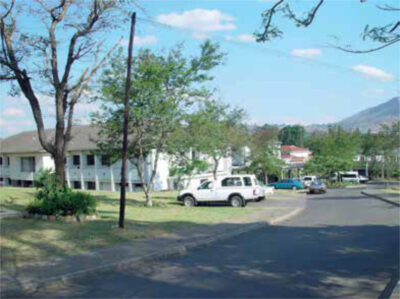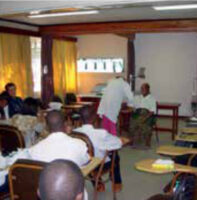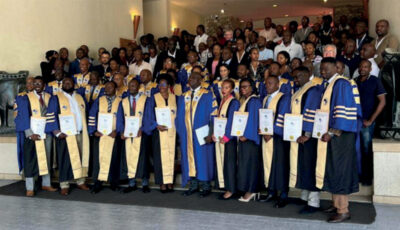Main content

There was no medical school in Malawi before the College of Medicine (CoM) was established in Blantyre in 1991. Students used to be sent to medical schools in neighbouring countries and later overseas, in particular to the UK, Australia, South Africa and the USA. Many did not return after graduation, and it was felt that the medical training received overseas was not appropriate for a doctor working in an African setting [1].
The curriculum at the CoM was introduced gradually. Because of the shortage of academic staff and infrastructure, students initially went abroad for the first study years and completed their clinical rotations in Malawi. After the basic science departments were established, the full curriculum could be delivered in Malawi. In 1998, the first students who had been fully trained in Malawi graduated. The curriculum was based on the traditional UK format and was reviewed by external consultants in several curriculum conferences. It is a 5-year programme that leads to a Medical Bachelor and Bachelor of Surgery (MBBS) degree. In each study year, students are exposed to community medicine, which plays a dominant role in the curriculum. There is a dedicated campus for this in Mangochi, one of the country’s rural districts. After another 18 months of internship (under the umbrella of the Ministry of Health), a doctor can register with the Medical Council of Malawi.
In 2008, the curriculum was reviewed and transformed into a more integrated format with early exposure of students to clinical sciences. In 2010, a second main campus was opened in Lilongwe (capital of Malawi) for teaching the third-year students, thus relieving pressure on the main campus in Blantyre.
In 2002, the first postgraduate programme was introduced (Master of Public Health). In 2004, the College, with support from the governments of the Netherlands, Norway and Sweden, started other postgraduate programmes in various clinical sciences: the Master of Medicine degrees in Internal Medicine, Paediatrics, Surgery, Obstetrics and Gynaecology, Anaesthesia and Ophthalmology. These programmes comprise a part I and part II (two years each) as well as a dissertation on a research project. For all components, an external examiner from outside Malawi is invited for quality assurance. Several Royal Colleges in the UK provided support for this initiative.
In the part I period of training in Malawi, the students work as registrars in their respective departments. The CoM is affiliated with the Queen Elizabeth Central Hospital (QECH), which has the status of a teaching hospital. Throughout the two years, time is also reserved for formal teaching. After passing the part I examination, students spend a specific period of time abroad in a country with the highest standards in clinical specialities. This is necessary because the current support services at QECH are not of a sufficient standard to provide adequate exposure and experience. South Africa is the obvious country of choice because it is a Southern African Development Community (SADC) neighbour, and the disease patterns are similar to those in Malawi. In addition, South Africa also has ‘Western diseases’ and relatively high standards in medicine. Significantly, visas for South Africa are easily granted for the duration of the training, after which it is impossible to stay. The trainee is therefore likely to return to Malawi. All posts are supernumerary and were initially funded by the Netherlands and later by the National AIDS Commission (NAC). This policy ensures that students can have positions as registrars with similar duties and learning opportunities as their South African counterparts, rather than being mere observers. After returning to Malawi, they prepare for the Part II examination and write their dissertation on a research project. Once graduated, they find positions as medical specialists in various departments, pursue an academic career, or become teachers themselves.
Recently, family medicine was introduced into the curriculum, and preparations are being made for a postgraduate programme.
In recent years, two more faculties were established under the College of Medicine, the Faculty of Biomedical Sciences and allied Health Professions, and the School of Public Health and Family Medicine. There are now degree programmes in physiotherapy, pharmacy, health services management, and medical laboratory sciences as well as upgrading degree programmes for clinical officers [2]. Increasingly, students from other (African) countries are being admitted to the CoM.
Recently (2015), a second medical school was established in Lilongwe by the Daeyang Luke University [2].
From the time the CoM was first established, academic staffing has heavily depended on expatriates. The clinical departments have been supported for many years by the Netherlands Ministry of Developmental Collaboration. In 1999-2001, for example, there were nine Dutch specialists appointed as teachers in the departments of Internal Medicine, Surgery, Obstetrics & Gynaecology and Anaesthesia. After 2001, an exit strategy was implemented with support for development of the postgraduate programme that also included improved infrastructure of the CoM clinical departments situated at QECH.
Research
Throughout the years, research has been a pivotal activity in the CoM curriculum, with dedicated time for student projects and formal teaching in research methodology. International collaboration, such as in the Malawi-Liverpool-Welcome Trust Clinical Research Programme and the John Hopkins Project, has been crucial in the development of the CoM. In addition, many research studies carried out in these collaborations have been instrumental in improving clinical care for patients throughout the country and beyond. The College has established the College of Medicine Research and Ethics Committee (COMREC) which assesses research proposals according to the highest international standards [3].
In 2006, the Research Support Centre was opened with the goal of building research capacity, supporting clinical trials, managing data, facilitating research, and administering grants [2]. In 2013, an impressive new library was opened to accommodate the teaching needs of around 1500 students.
Current situation and challenges
The College graduates about 60 medical doctors per year, and there are 20-30 non-medical graduates. In the post-graduate programme, there are 3-5 graduates per clinical specialty each year. [2] These numbers are too low to meet the demand, and it is still not possible to have the full postgraduate training in Malawi. One important restriction is the lack of adequate diagnostic facilities (laboratory, radiology, pathology, microbiology) in the QECH, although major improvements have been made.
Migration of doctors after graduation or specialization continues to be a threat. The lack of career development perspectives, research opportunities, and a realistic pay package that covers housing, transport and school fees for children are important contributing factors [4,5].
Although junior and senior positions have been taken up by well- trained Malawians in all departments, academic staffing remains problematic and is still dependent on expatriates. The clinical departments struggle with limited facilities and depend on the limited capacity of QECH support services. This has a negative effect on undergraduate and postgraduate teaching, as well as on clinical service delivery. Patients with complex conditions sometimes travel abroad, mainly to South Africa or India, often at their own expense and in some cases with support from the Ministry of Health [2].

Conclusion
The CoM is a success story, and this is the result of good management and political commitment. Increasingly, key positions in teaching and administration have been taken up by well-trained Malawian doctors and academics. While the economic situation in Malawi remains a matter for concern, there is good reason to assume that the next 25 years will be equally successful.
References
- Broadhead RL, Muula AS. Creating a medical school for Malawi: problems and achievements. BMJ 2002; 325: 384-87.
- Muula AS, Mulwafu W, Chiweza D, Mataya R. Reflections on the first twenty-five years of the University of Malawi College of Medicine. Malawi Med J 2016; 28: 75-78.
- Broadhead RL. Reflections on research at the College of Medicine: Excellence yesterday, today, tomorrow. Malawi Med J 2016; 28: 79-80.
- Bailey N, Mandeville KL, Rhodes T, et al. Postgraduate career intentions of medical students and recent graduates in Malawi: a qualitative study. BMC Medical education 2012; 12: 87.
- Zijlstra EE, Broadhead RL. The College of Medicine in the Republic of Malawi: towards sustainable staff development. Hum Resour Health 2007; 5:10.



















































